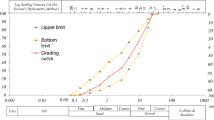Abstract
The nano scale of particles can result in dramatically improved or different properties from conventional grain-size materials of the same chemical composition. Therefore, it is practical to add nano-silica in particle form with 99.9% of SiO2 in nano scale to improve the characteristics of cement mortar. The compressive strengths of cement mortar were evaluated at various water-cementitious ratio. Five different water-cementitious ratios were used including, 0.23, 0.25, 0.32, 0.35, and 0.48 and four contents of nano-SiO2 particles, 3%, 6%, 9%, and 12% by weight of cement. The compressive strength of cement mortar with the addition of silica fume were also evaluated at w/cm ratio of 0.48 to compare with mortar containing nano-SiO2 particles and three contents of silica fume were: 5%, 10% and 15% by weight of cement. The experimental results show that the compressive strengths of mortars with nano-SiO2 particles were all higher than those of mortars containing silica fume at 7 and 28 days. It was demonstrated that the nano-particles were more valuable in enhancing strength than silica fume. This paper also analyzed some available examinations to monitor the hydration progress continuously, such as SEM observation, residual quantity test for Ca(OH)2 and the rate of heat evolution. The results of the examinations indicate that the SiO2 in nano scale behave not only as a filler to improve the microstructure, but also as an activator to promote pozzolanic reactions.
Similar content being viewed by others
References
Ang, A. H.-S. and Tang, W.H. (1975). “Probability concepts in engineering planning and design.”Volume I-Basic principles, John Wiley & Son, p. 244.
Concrete Society (1993). “Microsilica in concrete. Technical Report No. 41, TR.041. Wexham, Slough.”The Concrete Society.
Li, H., Xiao, H.-G., Yuan, J., and Ou, J. (2004). “Microstructure of cement mortar with nano-particles.”Composites Part B: Engineering, Vol. 35, pp. 185–189.
Toutanji, H. A. and El-Korchi, T. (1995). “The influence of silica fume on the compressive strength of cement paste and mortar.”Cement and Concrete Research, Vol. 25, pp. 1591–1602.
Mazloom, M., Ramezanianpour, A.A., and Brooks, J.J. (2004). “Effect of silica fume on mechanical properties of high-strength concrete.”Cement and Concrete Composites, Vol. 26, pp. 347–357.
Qing, Y. (2001). “Research on the comparison of pozzolanic activity between nano SiO2 and Silica fume.”Concrete.
Mendenhall, V., Scheaffer, R.I., and Wackerly, D.D. (1981). “Mathematical statistics with applications.”Duxbury Press, Second Edition, p. 390.
Zhang, Q., Wang, J., and Cheng, S. (2002). “Study on the CPE/Nano SiO2 blends.”J. Funct. Polym., pp. 271–275.
Author information
Authors and Affiliations
Corresponding authors
Rights and permissions
About this article
Cite this article
Jo, B.W., Kim, C.H. & Lim, J.H. Investigations on the development of powder concrete with nano-SiO2 particles. KSCE J Civ Eng 11, 37–42 (2007). https://doi.org/10.1007/BF02823370
Received:
Accepted:
Issue Date:
DOI: https://doi.org/10.1007/BF02823370




